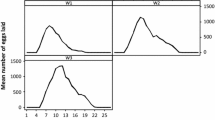Abstract
A test of host resistance to infestation by the tickRhipicephalus appendiculatus was repeated 5 times, at weekly intervals, on 2 initially susceptible calves. One hundred nymphs (NN) were used each time. Pairs of tick-susceptible rabbits served as controls. The engorged NN were weighed, then allowed to moult individually, and the sex of each was noted after emergence of the adult. During the course of the experiment there was a significant reduction in mean engorged weight (especially in the pre-male NN) and also in the length of the feeding period, and a downward trend in the percentage of NN which engorged. There was a significant increase in the percentage of engorged NN that moulted. Pre-male NN were significantly heavier than pre-female NN after feeding on susceptible hosts, but though mean feeding times were the same, they took 1–2 days longer to moult than pre-females at 28°C. It was concluded that the test itself could induce resistance if applied to fully susceptible calves.
Similar content being viewed by others
References
Bailey, K.P., 1960. Notes on the rearing ofRhipicephalus appendiculatus and their infection withTheileria parva for experimental transmission. Bull. Epizoot. Dis. Afr., 8: 33–43.
Bowessidjaou, J., Brossard, M. and Aeschliman, A., 1977. Effects and duration of resistance acquired by rabbits on feeding and egg-laying inIxodes ricinus L. Experientia, 33:528–530.
Branagan, D., 1973. The developmental periods of the Ixodid tickRhipicephalus appendiculatus Neum. under laboratory conditions. Bull. Entomol. Res. 63: 155–168.
Branagan, D., 1974. The feeding performance of the IxodidRhipicephalus appendiculatus Neum. on rabbits, cattle and other hosts. Bull. Entomol. Res., 64: 387–400.
Chiera, J.W., Newson, R.M. and Cunningham, M.P., 1985a. Cumulative effects of host resistance onRhipicephalus appendiculatus Neumann (Acarina: Ixodidae) in the laboratory. Parasitology, 90: 401–408.
Chiera, J.W., Newson, R.M. and Cunningham, M.P., 1985b. The effect of size on feeding and breeding performance ofRhipicephalus appendiculatus Neumann. Insect Sci. Appl., 6: 555–560.
De Castro, J.J., Cunningham, M.P., Dolan, T.T., Dransfield, R.D., Newson, R.M. and Young, A.S., 1985. Effects on cattle of artificial infestations with the tickRhipicephalus appendiculatus. Parasitology, 90: 21–33.
Fujisaki, K., 1978. Development of acquired resistance and precipitating antibody in rabbits experimentally infested with females ofHaemaphysalis longicornis (Ixodoidea: Ixodidae). Nat. Inst. Anim. Health Q., Tokyo, 18: 27–38.
Heller-Haupt, A., Varma, M.R.G. and Langi, A.O., 1981. Acquired resistance to ixodid ticks in laboratory animals. Trans. R. Soc. Trop. Med. Hyg., 75: 147–148.
Irvin, A.D. and Brocklesby, D.W., 1970. Rearing and maintainingRhipicephalus appendiculatus in the laboratory. J. Inst. Anim. Tech., 21: 106–112.
Irvin, A.D., Purnell, R.E. and Peirce, M.A., 1973. Some observations on the feeding behaviour of the tickRhipicephalus appendiculatus (Neumann, 1901) on cattle and rabbits in the laboratory. Trop. Anim. Health Prod. 5: 87–97.
Latif, A.A., 1984. Resistance toHyalomma anatolicum anatolicum Koch (1844) andRhipicephalus evertsi Neumann (1897) (Ixodoidea: Ixodidae) by cattle in the Sudan. Insect Sci. Appl., 5: 509–511.
McGowan, M. and Barker, R.W., 1980. A selected bibliography of tick-host resistance and immunological relationships. Bull. Entomol. Soc. Am. 26: 17–25.
Njau, B.C., 1985. Studies on resistance acquired by rabbits experimentally infected withRhipicephalus evertsi evertsi (Neumann, 1897) (Acarina: Ixodidae). Ph.D. thesis, University of Dares-Salaam (unpubl.), 239 pp.
Rubaire-Akiki, C.M. and Mutinga, M.J., 1980. Immunological reactions associated with rabbit resistance toRhipicephalus appendiculatus (Neumann) infestations. Bull. Anim. Health Prod. Afr., 28: 49–59.
Waladde, S.M., Kemp, D.H. and Rice, M.J., 1979. Feeding electrograms and fluid uptake measurements of cattle tickBoophilus microplus attached on artificial membranes. Int. J. Parasitol., 9: 89–95.
Author information
Authors and Affiliations
Rights and permissions
About this article
Cite this article
Newson, R.M., Chiera, J.W. Development of resistance in calves to nymphs ofRhipicephalus appendiculatus (Acarina: Ixodidae) during test feeds. Exp Appl Acarol 6, 19–27 (1989). https://doi.org/10.1007/BF01193230
Accepted:
Issue Date:
DOI: https://doi.org/10.1007/BF01193230




